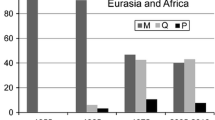Summary
P strains of Drosophila melanogaster are characterized by the presence of both full-length and deletion derivatives of the transposable element P in their genome, and by their ability to induce the syndrome of hybrid dysgenesis among the progeny of certain intra-strain crosses, when introduced through the male parents. In contrast, strains belonging to the M' class, and which were also found to bear P element-homologous sequences, lack this ability and this has been attributed to the presence in the genome of most of these strains of a distinct class of deletion derivatives termed KP, which can suppress the action of functional P factors. Here we demonstrate that KP elements are present, next to full-length ones, in the genome of at least three strains which induce P-M-like dysgenic symptoms, including GD sterility. KP elements form the majority of the P-homologous sequences in the strains MR-h12, 23.5/CyL 4 and the latter's derivative 23.5 */Cy. While the first one is a genuine P strain and the second one depicts a strong P cytotype, the third is a genuine M' strain. The hybrid dysgenesis induced by the two 23.5 MRF strains seems to be due, not primarily to the P elements, but to the action of hobo elements.
Similar content being viewed by others
References
Benton WD, Davis RW (1977) Screening λgt recombinant clones by hybridization to single plaques in situ. Science 196:180–182
Bingham PM, Levis R, Rubin GM (1981) The cloning of the DNA sequences from the while locus of Drosophila melanogaster using a novel and general method. Cell 25:693–704
Bingham PM, Kidwell MG, Rubin GM (1982) The molecular basis of hybrid dysgenesis: the role of the P element, a P-strain specific transposon family. Cell 29:995–1004
Black DM, Jackson MS, Kidwell MG, Dover GA (1987) KP elements repress P induced hybrid dysgenesis in Drosophila melanogaster. EMBO J 6:4125–4135
Church GM, Gilbert W (1984) Genomic sequencing. Proc Natl Acad Sci USA 81:1991–1995
Eeken JCJ, Sobels FH, Hyland V, Schalet AP (1985) Distribution of MR-induced sex-linked recessive lethal mutations in Drosophila melanogaster. Mutat Res 150:261–275
Eggleston WB, Johnson-Schlitz DM, Engels WR (1988) P-M hybrid dysgenesis does not mobilize other transposable element families in D. melanogaster. Nature 331:368–370
Engels WR (1979) Extrachromosomal control of mutability in Drosophila melanogaster. Proc Natl Acad Sci USA 76:4011–4015
Engels WR (1988) P elements in Drosophila. In: Berg DE, Howe MM (eds) Mobile DNA. American Society for Microbiology (in press)
Engels WR, Benz WK, Preston CR, Graham PL, Phillis RW, Robertson HM (1987) Somatic effects of P element activity in Drosophila melanogaster. Genetics 117:745–757
Ish-Horowicz D, Pinchin SM, Schedl P, Artavanis-Tsakonas S, Mirault M-E (1979) Genetic and molecular analysis of the 87A7 and 87C1 heat-inducible loci of D. melanogaster. Cell 18:1351–1358
Karess RE, Rubin GM (1984) Analysis of P element function in Drosophila. Cell 38:135–136
Kidwell MG (1981) Hybrid dysgenesis in Drosophila melanogaster. The genetics of cytotype determination in a neutral strain. Genetics 98:275–290
Laski FA, Rio DC, Rubin GM (1986) Tissue specificity of Drosophila P element transposition is regulated at the level of mRNA splicing. Cell 44:7–19
Lewis AP, Brookfield JFY (1987) Movement of Drosophila melanogaster transposable elements other than P elements in a P-M dysgenic cross. Mol Gen Genet 208:506–510
Murray NE (1983) Phage λ and molecular cloning. In: Hendrix RW, Roberts JW, Stahl FW, Weinberg RA (eds) Lambda II. Cold Spring Harbor Laboratory Press, Cold Spring Harbor, New York, pp 395–432
Nitasaka E, Mukai T, Yamazaki T (1987) Repressor of P elements in Drosophila melanogaster. Cytotype determination by a defective P element carrying only open reading frames 0 through 2. Proc Natl Acad Sci USA 84:7605–7608
O'Hare K, Rubin GM (1983) Structures of P transposable elements and their sites of insertion and excision in the Drosophila melanogaster genome. Cell 34:25–35
Rigby PWJ, Dieckmann M, Rhodes C, Berg P (1977) Labeling deoxyribonucleic acid to high specific activity in vitro by nick translation with DNA Polymerase I. J Mol Biol 113:237–251
Rio DC, Laski FA, Rubin GM (1986) Identification and immunochemical analysis of biologically active Drosophila P element transposase. Cell 44:21–32
Roiha H, Rubin GM, O'Hare K (1988) P element insertions and rearrangements at the singed locus of Drosophila melanogaster. Genetics 119:75–83
Rubin GM, Spradling AC (1982) Genetic transformation of Drosophila with transposable element vectors. Science 218:348–353
Scalenghe F, Turco E, Edstrom J, Pirotta V, Melli M (1981) Microdissection and cloning of DNA from a specific region of Drosophila melanogaster polytene chromosomes. Chromosoma 82:205–216
Southern EM (1975) Detection of specific sequences among DNA fragments separated by gel electrophoresis. J Mol Biol 98:503–517
Spradling AC (1986) P element-mediated transformation. In: Roberts DB (ed) Drosophila: a practical approach. IRL Press, Oxford, pp 175–197
Stamatis N, Yannopoulos G, Pelecanos M (1981) Comparative studies of two male recombination factors (MRF) isolated from a southern Greek Drosophila melanogaster population. Genet Res 38:125–135
Woodruff RC, Slatko B, Thompson Jr JN (1987) Hybrid dysgenesis in D. melanogaster is not a general release mechanism for DNA transposition. Science 237:1206–1207
Yannopoulos G, Stamatis N, Eeken JCJ (1986) Differences in the cytotype and hybrid dysgenesis inducing abilities of different P strains of Drosophila melanogaster. Experientia 42:1283–1285
Yannopoulos G, Stamatis N, Monastirioti M, Hatzopoulos P, Louis C (1987) hobo is responsible for the induction of hybrid dysgenesis by strains of Drosophila melanogaster bearing the male recombination factor 23.5 MRF. Cell 49:487–495
Author information
Authors and Affiliations
Additional information
Communicated by E. Bautz
Rights and permissions
About this article
Cite this article
Monastirioti, M., Hatzopoulos, P., Stamatis, N. et al. Cohabitation of KP and full-length P elements in the genome of MR strains inducing P-M-like hybrid dysgenesis in Drosophila melanogaster . Mol Gen Genet 215, 94–99 (1988). https://doi.org/10.1007/BF00331309
Received:
Issue Date:
DOI: https://doi.org/10.1007/BF00331309




